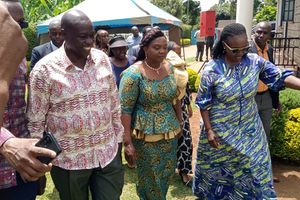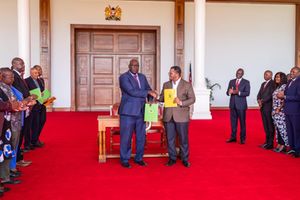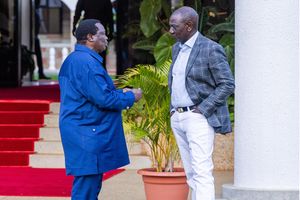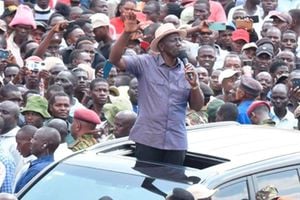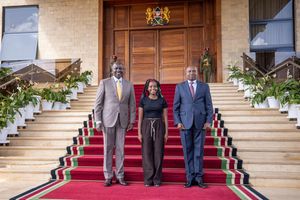
Political shifts expected to unfold in ways that will impact on jockeying for positions in Kenya Kwanza.
The merger of President William Ruto’s United Democratic Alliance with Prime Cabinet Secretary Musalia Mudavadi’s Amani National Congress provides clear indicators of the line-up’s taking shape leading towards the 2027 General Election.
That was just one of the pivotal moves at the beginning of 2025 that presages the political shifts to unfold in ways that will impact on jockeying for position within the Kenya Kwanza Alliance, especially around long-term issues of the presidential succession.
Much awaited also is the announcement of impeached Deputy President Rigathi Gachagua’s new political outfit expected to be unveiled at the end of this month.
Gachagua’s move will impact across the political spectrum as it will also set the stage for alliance-building that will inform the choice of candidate to be fronted against Ruto come the 2027 polls.
What remains of the fractured opposition Azimio coalition — nominally led by Wiper Party leader Kalonzo Musyoka, DAP-K leader Eugene Wamalwa and Mr Jeremiah Kioni, secretary-general of former President Uhuru Kenyatta’s wing of the Jubilee Party — will be paying close attention to Gachagua as whichever way he swings presumed control of the Mr Kenya bloc could be crucial in shaping the 2027 race.
Uhuru’s intentions will be closely watched as he seems to have rebounded strongly in the affections of Mt Kenya since the humiliation of the 2022 elections when his support for opposition chief Raila Odinga was roundly rejected in his home base.
Eyebrows were raised recently amid reports that the Uhuru Kenyatta and President Ruto had mended fences leading to appointment of the former’s Mt Kenya allies to the Cabinet, but the retired president seemed to have debunked such notions by recently breaking his silence and calling on the youth to keep up the struggle for their rights.
All formations aspiring to challenge Ruto will be keen to win the former president’s support if he can swing the Mt Kenya vote their way, but Gachagua also claims control of the massive pool.
Closely following events, also, will be former Interior Cabinet secretary Fred Matiangi, who recent reports suggest is also preparing to throw his hat into the ring, and expected Uhuru Kenyatta’s support, which would obviously be at the expense of Kalonzo Musyoka.
Another dynamic that cannot be ignored is the role of Raila Odinga’s ODM in the scramble for votes leading up to 2027 and the Ruto Succession.
The opposition titan effectively ditched Azimio in shifting his support to Ruto in return for backing in his quest for the African Union Commission chairmanship. The continental position would be an honourable retirement home away from the hurly-burly of local politics, but whatever the outcome of the African Union poll next month, Raila at 80 will still be called upon to provide crucial direction that could make or break Ruto’s re-election prospects.
Raila cosying up to Ruto, and getting ODM some key Cabinet slots, has raised prospects of the biggest opposition outfit getting into a formal pact that could definitely impact the power balance within the governing Kenya Kwanza coalition.
The party, however, sits uneasy as some of the beneficiaries of the broad-based government have been openly stating that ODM will support Ruto’s 2027 re-election bid but some key forces within rubbish any such claims; and insist the party is still focused on the quest to form the next government. Raila himself remains non-committal, but will be expected to provide direction in coming months.
For now, what is evident is that acknowledging reality of losing Mt Kenya, which propelled him to the presidency with nearly 50 per cent of his total vote in 2022, Ruto is shifting attention to the western part of the country, including Mudavadi’s western Kenya region and Raila’s Nyanza bastions, which he calculates will compensate for the fallout from Gachagua’s ouster.
Sealing of the UDA-ANC merger was followed Ruto leading an extensive campaign blitz in the western Kenya. Although he relinquished his party leadership on appointment to the Cabinet, Mr Mudavadi is still the acknowledged ANC supremo.
He was paraded on the western tour not just as the regional kingpin, but also as Ruto’s co-principal, notwithstanding that the party slot in the new merged line-up went to Lamu Governor Issa Timamy, who had assumed titular leadership when Mudavadi stepped aside.
Timamy came in as 2nd Deputy Party Leader while Gachagua’s successor as Deputy President, Prof Kithure Kindiki, was confirmed as 1st Deputy Party Leader.
That presents potential for rivalries. When moves were first pushed to tame Gachagua, for instance, one of the first strategies was to float creation of an extra post of deputy party leader to keep him in check.
It is thus likely that Kindiki’s supporters in the new structure will be looking askance at emergence of a second deputy.
With Ruto also moving aggressively to capture Raila’s Nyanza support base, there is likelihood that some will begin chipping away at Kindiki on the basis that he adds nothing to the ticket unless he can reclaim lost ground in Mt Kenya.
Indeed, there is every indication that Mudavadi would not have agreed for his ANC political vehicle to be ‘swallowed’ unless he can persuade his western Kenya base that there will be real political dividends, such as his being tapped for Ruto’s running mate in 2027, or being assured first slot for the presidential ticket at the subsequent election in 2032.
But such guarantees may not come easy, as that same carrot is also being dangled before Raila’s troops.
While ODM figures such as newly-minted Cabinet secretaries John Mbadi of National Treasury and Opiyo Wandayi of Energy are busy flying their ministerial flags and pledging allegiance to Ruto and support for his re-election bid, figures such as ODM Secretary-General Edwin Sifuna and Raila’s long-time comrades-in-arms, Nyanza Governor Prof Anyang’ Nyong’o who is the interim party leader and Siaya Governor James Orengo, have been urging caution.
They have warned against the sycophantic pro-Ruto noises coming from some of their ODM colleagues, insisting that the party retains its identity, is still committed to calling out shortcomings in government, and has not abandoned its aim to field a presidential candidate in the next general elections.
One can expect rivalries between the Raila and Mudavadi blocs as each positions for the presidential succession in the course of the year.
But one area they seem agreed on is Ruto’s very obvious game plan aimed at bolstering his support base in the Nyanza and western Kenya expanse as a counterpoint to the loss of support in Mt Kenya.
Across those two regions, as well as across Ruto’s own Rift Valley power base, the Coastal and the North Eastern regions, the message being relentlessly delivered is about the rest of the country uniting against the Mt Kenya region.
The populous region is accused of plotting against Ruto’s leadership in order to reclaim a political and economic dominance that has produced three of Kenya’s five presidents, a majority of the country’s wealthiest people and allegedly, more than its fair share of development resources.
The ongoing campaigns seem like a replay of the ‘41 against 1’ (numbers representing ethnic communities) game-plan deployed by the then Raila-Ruto-Mudavadi axis against President Mwai Kibaki at the tainted 2007 elections.
It might seem odd that while Ruto is actively trying to reclaim lost ground in Mt Kenya by wooing Uhuru and appointing figures from the region to the cabinet (Mutahi Kagwe at Agriculture, William Kabogo at Communications and Lee Kinyanjui at Investments, Trade and Industry) and other senior positions, his minions are at the same time loudly proclaiming policies aimed at isolating the populous region, and blaming out for all the challenges faced.
That places Kindiki and other senior figures detailed to placate the restive region in an awkward positions as they are clearly fighting a losing battle trying to undo the violent rhetoric coming from the movers and shakers in Ruto’s inner circle.
Going to the extent of deploying Maina Njenga, former leader of the proscribed Mungiki sect-cum-criminal gang, to counter Gachagua in Mt Kenya is also likely to be counter-productive.
Meanwhile, it remains to be seen how everything else will shape up. Following Raila’s exit form Azimio, Kalonzo Musyoka moved speedily to position himself as front-runner for the opposition presidential ticket, with Eugene Wamalwa as his presumed running-mate.
But that would be a puny effort unless it secures support of the Mt Kenya region. Unless his impeachment is overturned by the courts, Gachagua will be barred from running, and aware of this has been prepared to throw his weight behind Kalonzo. But he would extract a weighty price, probably demanding the right to have his own Mt Kenya nominee as running mate.
Kalonzo has also been trying to secure Uhuru’s support, but there may be complications because the former president and the impeached Deputy President don’t see eye-to-eye, and will be rivals to in the race to control the same voting bloc.
If it can be taken the Jubilee spokesman, Kioni, speaks for Uhuru, the party is also conscious that it will fall into a Ruto trap if it fields a presidential candidate from Mt Kenya. Hence Kalonzo might remain hopeful of powerful endorsement, but it is emerging that Uhuru views Matiangi, the powerful Interior CS under his regime, as a more forceful and decisive candidate.
There are almost uncertainties on the ‘tribeless, leadersless’ Gen Z vote which in June 2024 shook the landscape with an unprecedented revolt.
The drive, energy and enthusiasm seems to have dissipated, but there is still a large floating youth base which if not expressing itself on the streets might do son on the ballot.
Newcomers such as Busia Senator Okiya Omtata will be out to secure support on disenchanted youth, but he can be assured many more will come up. Uhuru recently raised eyebrows by calling on the youth to fight for the rights, but whether he will put his money where his mouth is remains to be seen.
At the moment, one can only conclude that things are still unfolding on both the opposition and government fronts. On the former, the scenario is extremely fluid and certain to see numerous twists and turns. On the later Ruto will certainly be a candidate for re-election, and with the advantage of incumbency and control of government machinery and resources should be a clear frontrunner.
But the unexpected can happen at any time. A weakened Ruto unable to compensate for loss of Mt Kenya will be vulnerable to pressure from within his own support base, especially if Raila fails to get what he wants and threatens a mass walkout like he did to President Moi in 2022.
There is also likelihood, borrowing from the Moi script, that Ruto will look to sponsor a Mt Kenya presidential candidate against himself, so as to dilute whatever direction Uhuru and Gachagua may try to direct the populous vote.

